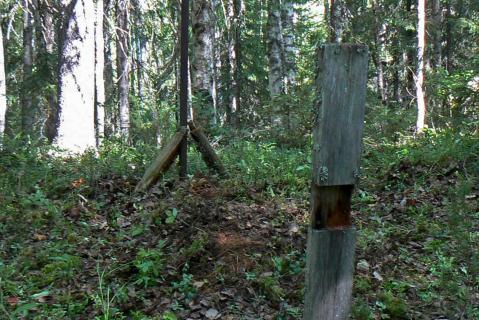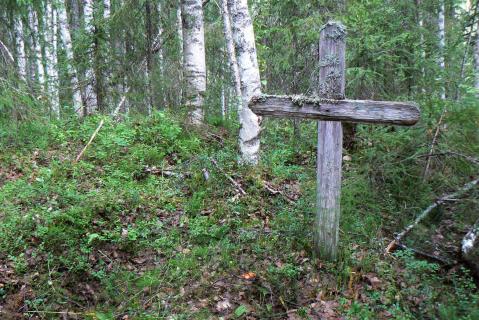Special settlement No 61 (Ulskoe) in the Kholmogorsky district came into existence in 1930. From spring 1940 onwards Polish citizens deported from the western territories occupied by the USSR began to arrive here. On 1 January 1941 there was a population of 652 people: 413 Poles, 74 Ukrainians, 141 Belorussians and 24 of other nationalities.
The graveyard was a kilometre southwest of the village and burials had taken place there since 1930. Poles who died in settlement 61 and in Babrikha, 6 kms from Ulskoe, were buried there. There are no lists of the deceased, only a few names are known. In 1980 V.A. Durasov, a former inhabitant of Ulskoe removed the name plate from the grave of Antony Janiszewski to prevent it from further damage and it is preserved in the Kholmogory village museum.
In 2010, a Polish expedition, which included representatives of the Polish Consulate in St Petersburg and the Arkhangelsk Region Polonia society, investigated the cemetery. Trees had grown up on the site and most of the nameplates had disappeared. 22 burial mounds and 4 crosses (3 wooden, one metal) were discovered. None of the crosses bore a name.
The Memorial online database (2021) includes the names of 56,173 Polish citizens deported to the Arkhangelsk Region and records that 3,872 died there. (The source is the 1997 database mentioned elsewhere.) 36,454 of the deportees were men and women of Polish nationality, 4,904 of Belorussian nationality, 11,883 were Jewish and 1,894 Ukrainians.
The database lists 673 deportees sent to Ulskoe, 53 of whom died there. 435 were men and women of Polish nationality, 139 were Belorussian and 76 were Ukrainians.
| Date | Nature of ceremonies | Organiser or responsible person | Participants | Frequency |
|---|---|---|---|---|
|
nk
|
Commemorative Services
|
nk
|
nk
|
From time to time
|
| State of burials | Area | Boundaries |
|---|---|---|
|
Trees have taken over the site; nameplates have disappeared and only a few crosses remain
|
Not determined
|
Not delineated
|
[ Original texts & hyperlinks ]
A. Dembovska, The Poles in the Russian North: An album of Polish sites of remembrance, St Petersburg, 2011
“Materials of the Union of Siberians in Bystrzyca Kłodzka (Poland)”. Report by Jan Kobryn, 19 January 2013 – Archive RIC Memorial (St Petersburg)
Ostolski J., Co to jest wojna? Wspomnienia dziecka (1938-1948), Warsaw, 1999 (in Polish)
*
“Cemetery of the former special settlement No 61 (Ulskoe)”, Virtual Museum of the Gulag [retrieved, 28 May 2022; no longer accessible]


